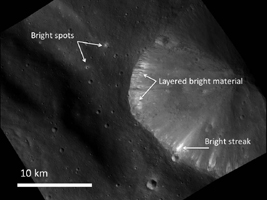
Annotated version
Click on the image for larger viewThis image from NASA's Dawn spacecraft shows the brightest area seen on Vesta so far. It shows a crater located inside the rim of the Rheasilvia basin at the south pole of Vesta. The crater is on the edges of the Rheasilvia, Urbinia, and Pinaria quadrangles.
This image is part of a set of images taken by Dawn's framing cameras on Dec. 27, 2011, during the mission's low-altitude mapping orbit (on average 130 miles or 210 kilometers above the surface). This particular image was about 156 miles (230 kilometers) above the surface and covers an area about 250 square miles (600 square kilometers).
The Dawn mission to the asteroids Vesta and Ceres is managed by NASA's Jet Propulsion Laboratory, a division of the California Institute of Technology in Pasadena, for NASA's Science Mission Directorate, Washington. Dawn is a project of the directorate's Discovery Program, managed by NASA's Marshall Space Flight Center in Huntsville, Ala. UCLA is responsible for overall Dawn mission science. The Dawn Framing Cameras have been developed and built under the leadership of the Max Planck Institute for Solar System Research, Katlenburg-Lindau, Germany, with significant contributions by DLR German Aerospace Center, Institute of Planetary Research, Berlin, and in coordination with the Institute of Computer and Communication Network Engineering, Braunschweig. The framing camera project is funded by the Max Planck Society, DLR, and NASA/JPL.
More information about the Dawn mission is online at http://www.nasa.gov/dawn and http://dawn.jpl.nasa.gov.

